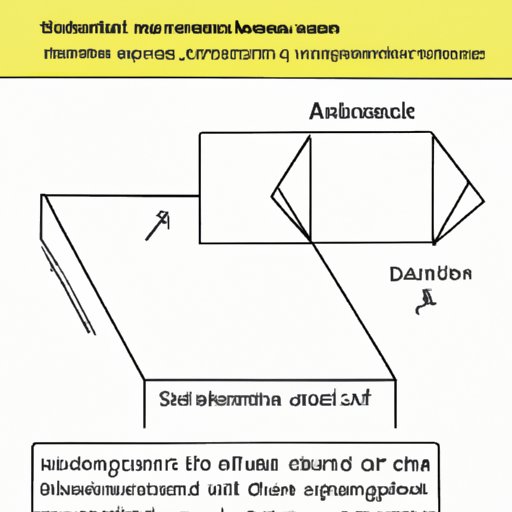Introduction
A trapezoid is a geometrical shape with four sides, where two of the sides are parallel but of different length. The other two sides are not parallel to each other. To calculate the area of any trapezoid, you need to use a specific formula that takes into account the length of each side. Finding the area of a trapezoid is an important skill in geometry, and it also has practical applications like determining the size of a rug or the amount of paint needed for a trapezoidal wall. This article will guide you through how to find the area of a trapezoid step-by-step and provide real-world scenarios to better understand the concept.
Step-by-Step Guide
The formula for calculating the area of a trapezoid is:
A = ((b1 + b2) / 2) × h
Where b1 and b2 are the lengths of the parallel sides and h is the height (the perpendicular distance between the two parallel sides).
Step 1: Measure the lengths of the parallel sides (b1 and b2) and the height (h) of the trapezoid.
Step 2: Add the lengths of the parallel sides (b1 and b2) together and then divide the sum by 2. In other words, find the average length of the parallel sides. The result is called the “average length” of the trapezoid.
Step 3: Multiply the “average length” obtained from step 2 with the height (h) of the trapezoid.
Step 4: The answer obtained from step 3 is the area (A) of the trapezoid in square units.
For example, let’s say you have a trapezoid with a height (h) of 4 inches and parallel sides of length 8 and 12 inches. The average length of the trapezoid is (8 + 12) / 2 = 10. Therefore, the area of the trapezoid is
A = ((8 + 12) / 2) × 4 = 40 square inches.
It is important to note that the height of a trapezoid is always perpendicular to the parallel sides. Therefore, if you are given a trapezoid with an angle, you can use trigonometry to determine the height of the trapezoid.
Real-World Scenarios
Calculating the area of a trapezoid has practical applications in real-world scenarios as well. For example, when purchasing a rug for your home, it is important to know the size of the rug that fits in a particular space. If the shape of the space is that of a trapezoid, finding the area can help you determine the size of the rug you need.
Furthermore, if you want to paint a trapezoid-shaped wall, you can use the area formula to determine the amount of paint you need to cover the entire wall.
Let’s take the example of a rectangular swimming pool with a trapezoidal shallow end. By calculating the area of the shallow end of the pool, you can determine the amount of water needed to fill the pool accurately. You can also use the formula to check whether your pool water volume is too high or too low following regular swimming pool maintenance. This accuracy is essential for large commercial pools where even a minor error can cause significant wastage of water and chemicals.
Comparison with Other Shapes
Compared to other shapes, trapezoids are unique as they have two parallel sides but are not a regular shape like a square or rectangle. The formula used to calculate the area of a trapezoid is different from the formula used to calculate the area of a triangle or rectangle. In a triangle, the formula is “A = (b × h) / 2”. For a rectangle, the formula is “A = l × w”. By learning how to find the area of a trapezoid, you will expand your understanding of geometry and enhance your problem-solving skills.
The importance of finding the area of a trapezoid cannot be understated. Real-world scenarios like rug sizing, pool maintenance, or painting trapezoid-shaped walls all need a grasp of this formula to calculate and predict measures. Similarly, in mathematics, the concept of the area of a trapezoid is a step towards understanding more advanced concepts. The formula is used to find the volume of more complex three-dimensional shapes too.
Interactive Quiz
Test your knowledge of finding the area of a trapezoid with our interactive quiz. This quiz will ask you the formula for finding the area of a trapezoid and provide you with step-by-step questions to verify your understanding.
Video Tutorial
If you are someone who learns better with visual aids, a video tutorial will serve as a comprehensive aid for you. A video tutorial can demonstrate each step of finding the area of a trapezoid visually and with audio narration.
FAQ Style Article
Here are some common questions and answers about finding the area of a trapezoid:
Q: Can a trapezoid have two right angles?
A: No, a trapezoid cannot have two right angles. At a maximum, a trapezoid can have one right angle.
Q: What if the trapezoid is an isosceles trapezoid?
A: If the trapezoid is an isosceles trapezoid, that means that the two parallel sides have the same length. This simplifies the formula to “A = b × h”
Q: Are there any real-life examples of trapezoidal shapes?
A: Yes, trapezoids can be found in various aspects of everyday life-like tables or swimming pools with a sloping roof.
Conclusion
In conclusion, finding the area of a trapezoid is an important skill in geometry and everyday life. This formula’s practical applications, such as determining the size of a rug or planning a swimming pool renovation, make it an essential equation in problem-solving. Additionally, using the formula expands the understanding of geometry and improves mathematical abilities. By following a straightforward step-by-step guide, utilizing real-world examples, and taking advantage of interactive tools like a quiz and video tutorial, an understanding of the area of a trapezoid can be quickly and effectively achieved.
